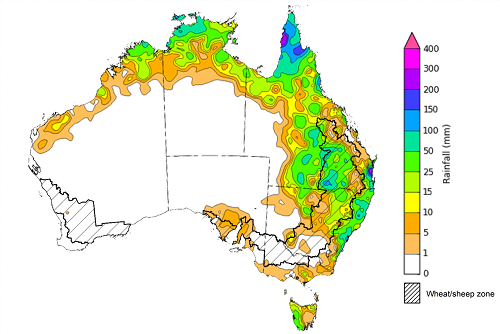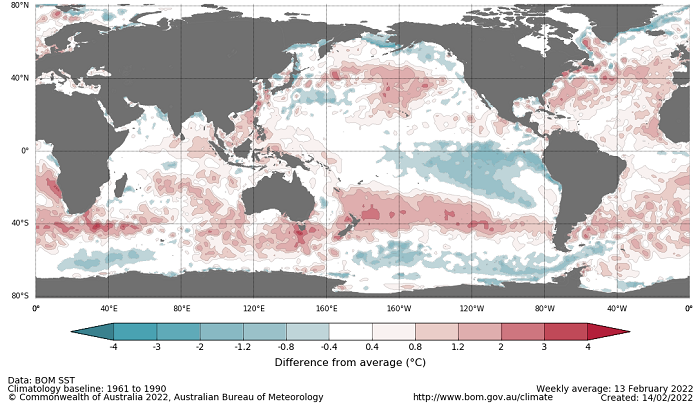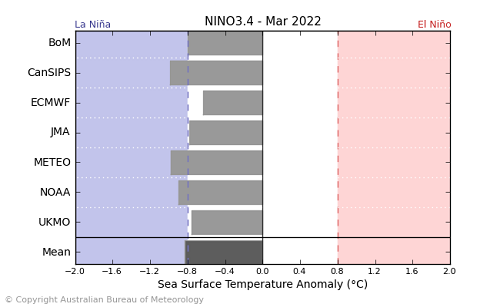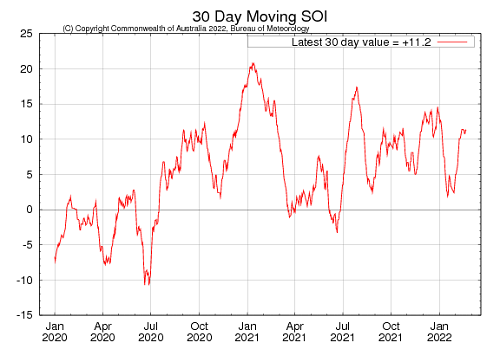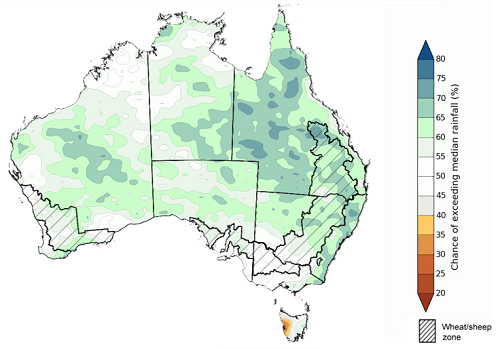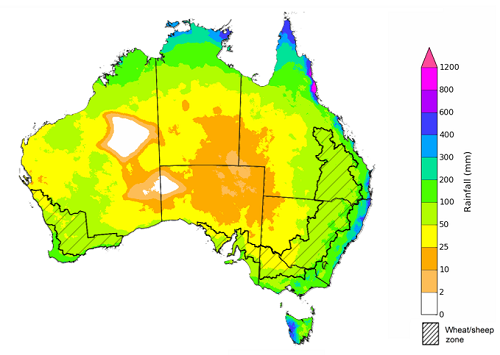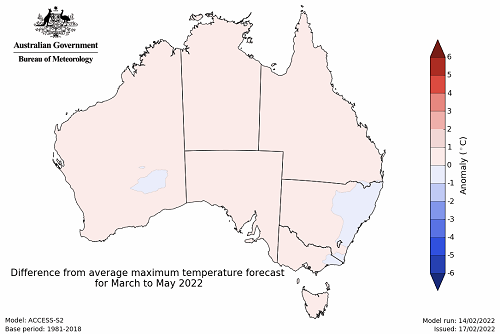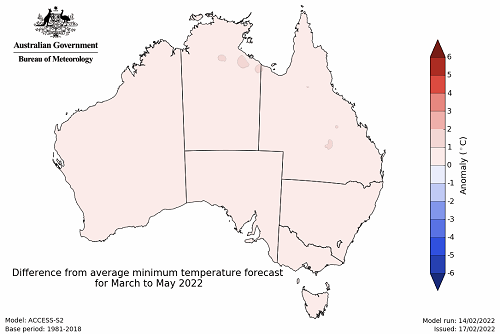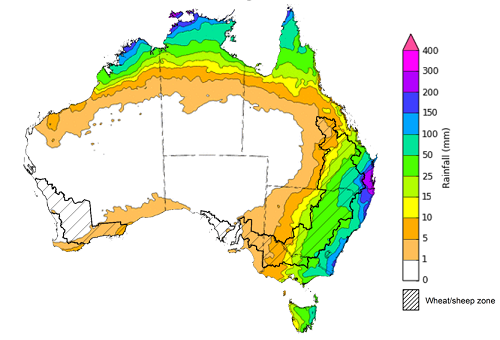Key issues
- For the week ending 23 February 2022, low-pressure troughs brought rainfall to northern and eastern parts of the country. In recent days, intense storms resulted in localised flooding to parts of northern New South Wales and south-east Queensland. In the south, high-pressure systems resulted in clear, dry conditions for large areas of central, western and southern Australia.
- Harvesting of early sown summer crops in northern New South Wales and southern Queensland is nearing its end. However, rainfall over the last week has likely stalled harvesting activity in some regions. Nevertheless, yields and grain quality for early sown crops have been exceptional so far. Likewise in the Central Queensland cropping region, the recent rainfall likely interrupted sowing activity of late planted crops as sowing draws to a close.
- El Niño-Southern Oscillation (ENSO) indicators suggest that La Niña is currently active in the tropical Pacific. La Niña events are associated with above-average rainfall for northern and eastern Australia during summer and to a lesser degree, autumn. International climate models expect the La Niña event will dissipate over the coming months.
- The outlook for March 2022 indicated wetter than average conditions are expected across much of eastern, central and south-western Australia. The wetter than average conditions expected for most eastern Australian cropping regions is likely to support the growth and development of late sown summer crops but may interfere with the harvesting of early sown crops in New South Wales and Queensland.
- The outlook for March to May 2022 suggests, there is a 75% chance of receiving between 50 and 100 millimetres across cropping regions in New South Wales, Queensland, southern Victoria, Western Australia and parts of South Australia. While these rainfall totals are close to average for this three-month period, soil moisture levels are average to above average across most summer cropping regions in New South Wales and Queensland which will support current above average yield potentials.
- Over the 8-days to 3 March 2022, low-pressure troughs in eastern Australia are expected to draw in moisture-laden air resulting in heavy rainfall and continued localised flooding for parts of New South Wales and Queensland. Likewise, low-pressure systems in northern Australia are expected to result in substantial rainfall. Meanwhile, high pressure systems are expected to bring mostly dry conditions to much of western, central and southern Australia.
- Water storage in the Murray–Darling Basin (MDB) decreased by 85 gigalitres (GL) between 16 February 2022 and 23 February 2022. The current volume of water held in storage is 22,137 GL, which represents 88 of total capacity. This is 66% or 9,036 GL more than at the same time last year.
- Allocation prices in the Victorian Murray below the Barmah Choke increased from $64 per ML on 11 February 2022 to $66 per ML on 19 February 2022. Prices are lower in the Goulburn-Broken, Murrumbidgee, and regions above the Barmah Choke due to the binding of the Goulburn intervalley trade limit, Murrumbidgee export limit, and Barmah Choke trade constraint.
Climate
For the week ending 23 February 2022, low-pressure troughs brought rainfall to northern and eastern parts of the country. In recent days, intense storms resulted in localised flooding to parts of northern New South Wales and south-east Queensland. In the south, high-pressure systems resulted in clear, dry conditions for large areas of central, western and southern Australia.
Rainfall totals of between 10 and 100 millimetres were recorded across much of Queensland, parts of northern and eastern New South Wales, south-eastern Victoria, western Tasmania as well as northern parts of Western Australia and the Northern Territory. Rainfall totals in excess of 100 millimetres were recorded in parts of southern, central and northern Queensland, north-eastern New South Wales and the far north of the Northern Territory. Remaining parts of Australia received little to no rainfall.
In cropping regions, rainfall totals of between 10 and 100 millimetres were recorded across northern parts of New South Wales and much of Queensland. Little to no rainfall was recorded across cropping regions in remaining parts of New South Wales, as well as Victoria, South Australia and Western Australia.
Harvesting of early sown summer crops in northern New South Wales and southern Queensland is nearing its end. However, rainfall over the last week has likely stalled harvesting activity in some regions. Nevertheless, yields and grain quality for early sown crops have been exceptional so far. Likewise in the Central Queensland cropping region, the recent rainfall likely interrupted sowing activity of late planted crops as sowing draws to a close. Given the below average to average soil moisture levels at the start of February, this recent rainfall would have improved plant available water for late sown crops.
Rainfall for the week ending 23 February 2022
Note: The rainfall analyses and associated maps utilise data contained in the Bureau of Meteorology climate database, the Australian Data Archive for Meteorology (ADAM). The analyses are initially produced automatically from real-time data with limited quality control. They are intended to provide a general overview of rainfall across Australia as quickly as possible after the observations are received. For further information go to http://www.bom.gov.au/climate/rainfall/
Throughout summer the climate drivers with the largest potential impact on Australia’s climate patterns are the El Niño–Southern Oscillation (ENSO), the Southern Annular Mode (SAM) and the Madden-Julian Oscillation (MJO). These climate drivers are likely to influence the growth and development of summer crops in northern growing regions and pasture growth across northern Australia with the northern wet season.
ENSO indicators suggest that La Niña is currently active in the tropical Pacific. International climate models expect the La Niña event will dissipate over the coming months. La Niña increases the chance of tropical cyclones and above average rainfall across northern and eastern Australia during summer and to a lesser degree, autumn. As La Niña weakens it can continue to influence global weather and climate.
The MJO is also expected to influence rainfall patterns in Australia over the coming weeks, increasing the likelihood of above average rainfall across northern Australia, and also across tropical regions to Australia's north.
The Southern Annular Mode (SAM) is neutral, and is forecast to remain neutral over the coming three weeks. A neutral SAM has little influence on Australian climate.
Below average sea surface temperature (SST) anomalies have persisted in the central and eastern tropical Pacific Ocean over the past two weeks. SST in the equatorial Pacific are expected to begin warming as sub-surface waters become warmer. Current SST anomalies reflect typical La Niña patterns, with below average SST along the equator, and warm SST anomalies to the north and south. Despite the easing of negative Indian Ocean Dipole (IOD) conditions, warm SST anomalies persist to the north-west of Australia.
Difference from average sea surface temperature observations 7 to 13 February 2022
International climate model outlooks for the NINO 3.4 region in March 2022
A La Niña event is currently at or near its peak in the Pacific Ocean. Most climate models surveyed by the Bureau of Meteorology expect the La Niña event to dissipate in early autumn, with only two of the seven models expecting it to remain active in May 2022. ENSO events typically decay and return to neutral conditions in autumn. For the period ending 23 February 2022, the 30-day SOI was +11.2. For the period ending 13 February 2022, the 90-SOI was +9.3, both above the La Niña threshold of +7. Above average SST anomalies have continued across parts of the Maritime Continent and northern Australia. Trade winds across the western tropical Pacific have remained stronger than average, while cloudiness near the Date Line has been consistently below average since June 2021.These indications are consistent with the ongoing La Niña event.
30-day Southern Oscillation Index (SOI) values ending 23 February 2022
As at 21 February 2022 the Madden–Julian Oscillation (MJO) is currently over the eastern Indian Ocean. Most climate models suggest the MJO is likely to progress eastwards into the Maritime Continent in the coming week. The MJO is a pulse of cloud and rainfall that moves eastward along the equator and increases the chance of above average cloudiness and rainfall across northern Australia.
Madden–Julian Oscillation (MJO) daily index
These climate outlooks are generated by ACCESS–S (Australian Community Climate Earth-System Simulator–Seasonal). ACCESS–S is the Bureau of Meteorology's dynamical (physics-based) weather and climate model used for monthly, seasonal and longer-lead climate outlooks.
For further information, go to http://www.bom.gov.au/climate/ahead/about/
The Bureau of Meteorology’s latest rainfall outlook indicated wetter than average conditions are expected across large areas of Australia during March. The ACCESS-S climate model suggests there is close to a 55% chance of exceeding median March rainfall totals across much of eastern, central and south-western Australia.
The outlook for March 2022 indicates that there is a 75% chance of rainfall totals between 10 and 100 millimetres across eastern New South Wales, eastern and northern Queensland, southern Victoria, the north of Western Australia and the Northern Territory, and Tasmania. Rainfall totals in excess of 100 millimetres are expected in parts of north-eastern New South Wales, northern Queensland, the north of the Northern Territory and Western Australia, and western Tasmania.
Across cropping regions there is a 75% chance of rainfall totals of between 10 and 50 millimetres across most of New South Wales, Queensland and eastern parts of Western Australia. There is a 75% chance of rainfall less than 10 millimetres for most of Victoria, South Australia and remaining parts of Western Australia. The wetter than average conditions expected for most eastern Australian cropping regions is likely to support the growth and development of late sown summer crops but may interfere with the harvesting of early sown crops in New South Wales and Queensland.
Rainfall totals that have a 75% chance of occurring March 2022
The rainfall outlook for March to May 2022 suggests there is a greater than 55% chance of exceeding median rainfall across much of New South Wales and Queensland, South Australia, Western Australia, the Northern Territory and parts of Victoria. For much of Queensland, there is a greater than 65% chance of exceeding median rainfall. For remaining regions of Australia, there is roughly an equal chance of above and below median rainfall, with only isolates areas western Tasmania expected to receive below average rainfall between March and May 2022 (Bureau of Meteorology ‘National Climate Outlook’, 17 February 2022).
Bureau of Meteorology rainfall outlooks for March to May have greater than 55% past accuracy across most of eastern and central Australia. Outlook accuracy is greater than 65% across northern Australia. However, there is low past accuracy for parts of north-western New South Wales, western Queensland, the north-east and north-west of South Australia, as well as large areas in southern parts of Western Australia.
Chance of exceeding the median rainfall March to May 2022
The outlook for March to May 2022 suggests there is a 75% chance of rainfall totals between 50 and 200 millimetres across much of eastern New South Wales, eastern and northern Queensland, southern Victoria, southern parts of South Australia, the south-west and far north of Western Australia, northern parts of the Northern Territory and eastern Tasmania. Rainfall totals in excess of 200 millimetres are forecast for north-eastern New South Wales, northern parts of Queensland and the Northern Territory and western Tasmania.
Across cropping regions, there is a 75% chance of receiving between 50 and 100 millimetres across much of New South Wales, Queensland, southern Victoria, Western Australia and parts of South Australia. Rainfall totals in excess of 100 millimetres are forecast for some north-eastern cropping regions in New South Wales. Totals of less than 50 millimetres are expected across remaining cropping regions in Victoria, and South Australia and Western Australia.
While these rainfall totals are close to average for this three-month period, soil moisture levels are average to above average across most summer cropping regions in New South Wales and Queensland. Following recent rainfall, upper layer soil moisture levels are average to above average, which is likely to benefit the germination and establishment of late sown summer crops. Lower soil moisture levels are also average to above average, which will support current above average yield potentials of earlier sown crops. For late sown summer crops, more rainfall will be required over the coming weeks to support ongoing development and yield potentials.
Rainfall totals that have a 75% chance of occurring March to May 2022
The temperature outlook for March to May 2022 indicates that maximum temperatures across most of Australia are likely to be close to the 1990-2012 average (- 1°C to 1°C). Minimum temperatures are expected to be slightly above average for parts of Queensland and the Northern Territory, and close to average for the rest of Australia (Bureau of Meteorology ‘National Climate Outlook’, 17 February 2022).
Predicted maximum temperature anomaly for March to May 2022
Predicted minimum temperature anomaly for March to May 2022
Over the 8-days to 3 March 2022, low-pressure troughs in eastern Australia are expected to draw in moisture-laden air resulting in heavy rainfall and continued localised flooding for parts of New South Wales and Queensland. Likewise, low-pressure systems in northern Australia are expected to result in substantial rainfall. Meanwhile, high pressure systems are expected to bring mostly dry conditions to much of western, central and southern Australia.
Rainfall totals of between 10 and 100 millimetres are forecast for eastern New South Wales and Victoria, eastern and northern parts of Queensland, as well as northern parts of Western Australia, the Northern Territory and much of Tasmania. Rainfall in excess of 100 millimetres is expected in coastal areas of eastern New South Wales, Victoria and Queensland, as well as northern parts of Queensland, Western Australia and the Northern Territory.
In Australian cropping regions, rainfall totals of between 10 and 100 millimetres are expected across New South Wales, much of Queensland and eastern Victoria. Little to no rainfall is forecast for all remaining cropping regions during the next 8-days.
The forecast rainfall across summer cropping regions will further add to the rainfall received over the past week, increasing soil moisture levels. As a consequence, the tail end of harvesting of early sown summer crops is likely to be delayed in northern New South Wales and southern Queensland. For later sown summer crops, the expected rainfall will improve plant available moisture and assist with crop establishment. For early sown crops with longer growth periods, the expected rainfall will help support them through critical stages of flowering and filling.
Total forecast rainfall (mm) for the period 24 February to 3 March 2022
Note: This rainfall forecast is produced from computer models. As the model outputs are not altered by weather forecasters, it is important to check local forecasts and warnings issued by the Bureau of Meteorology.
Water
Water storages, water markets and water allocations - current week
The Tableau dashboard may not meet accessibility requirements. For information about the contents of these dashboards contact ABARES.
Commodities
Information on weekly price changes in agricultural commodities is now available at the Weekly commodity price update.

